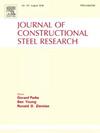长期应变时效对低碳结构钢的影响
IF 4
2区 工程技术
Q1 CONSTRUCTION & BUILDING TECHNOLOGY
引用次数: 0
摘要
实验研究了中国和日本低碳结构钢的长期应变老化对应力-应变行为的影响。在试验方案中,评估了预应变水平(2% - 8%)和老化时间(7 - 180天)对屈服强度、极限强度、屈服-极限强度比和延性的影响。结果表明,将预应变水平提高至8%,屈服强度和极限抗拉强度分别提高54%和7%,但塑性降低48.4%(由极限应变可知)。此外,将老化时间延长至90天,产量和极限强度分别进一步提高了6%和4%。定量分析还表明,应变老化处理可以影响屈服与极限强度比,高预应变水平导致该比率超过现行设计规范规定的限值0.85。应变老化对四类结构钢强度比和延性的影响基本一致,但应变老化对屈服强度和极限强度的影响变化不大。基于本研究的试验结果和文献中收集的补充数据库,提出了一种考虑应变老化效应的改进的四线性应力应变模型(QLMSA),该模型考虑了预应变对低碳结构钢应力应变特性的影响。所提出的模型已被证明可以准确地预测长期应变老化对标称屈服强度为235 MPa至355 MPa的低碳结构钢的应力-应变行为的影响。本文章由计算机程序翻译,如有差异,请以英文原文为准。

Long-term strain ageing effects on low-carbon structural steels
This paper experimentally investigates the long-term strain ageing effects on the stress-strain behaviour of low-carbon structural steels manufactured in both China and Japan. In the experimental programme, the effects of pre-strain levels (ranging from 2% to 8%) and ageing durations (ranging from 7 to 180 days) on yield strength, ultimate strength, yield-to-ultimate strength ratio, and ductility were assessed. The results revealed that increasing the pre-strain level to 8% resulted in enhancements of 54% and 7% in the yield and ultimate tensile strengths, respectively, accompained by a 48.4% reduction in ductility, as indicated by the ultimate strain. Moreover, extending the ageing duration to 90 days led to further increases in the yield and ultimate strengths by up to 6% and 4%, respectively. Quantitative analysis also revealed that strain ageing treatments can affect the yield-to-ultimate strength ratio, with high pre-strain levels causing the ratio to exceed the limit value of 0.85 specified in current design codes. Although the influence of strain ageing on the strength ratio and ductility was generally consistent across the four categories of structural steels, minor variations were observed in the effect of strain ageing on the yield and ultimate strengths. Based on the test results obtained from the present study and supplementary database collected from the literature, a modified quad-linear stress-strain model considering strain ageing effects (QLMSA) was proposed, accounting for the pre-strain effects on the stress-strain characteristics of low carbon structural steels. The proposed models have been shown to accurately predict the long-term strain ageing effects on the stress-strain behaviour of low-carbon structural steels with nominal yield strengths ranging from 235 MPa to 355 MPa.
求助全文
通过发布文献求助,成功后即可免费获取论文全文。
去求助
来源期刊

Journal of Constructional Steel Research
工程技术-工程:土木
CiteScore
7.90
自引率
19.50%
发文量
550
审稿时长
46 days
期刊介绍:
The Journal of Constructional Steel Research provides an international forum for the presentation and discussion of the latest developments in structural steel research and their applications. It is aimed not only at researchers but also at those likely to be most affected by research results, i.e. designers and fabricators. Original papers of a high standard dealing with all aspects of steel research including theoretical and experimental research on elements, assemblages, connection and material properties are considered for publication.
 求助内容:
求助内容: 应助结果提醒方式:
应助结果提醒方式:


